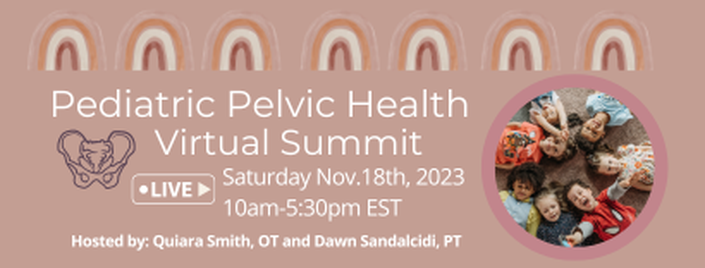
What will I learn in level 2?
Now that you've got some experience working with children with bowel and bladder issues do you feel like you have more questions than answers? I did which is why I created this course.
For a complete list of the course curriculum click on the preview below.

Searching for answers?
- What about motility?
- How slow is slow transit?
- How do I stop the "Constipation Carousel" of constant clean outs and continued encopresis?
- How can I titrate medications safely?
- How can I help kiddos with imperforate anus and post op Hirschsprung pull through surgeries?
- Can I safely do rectal balloon training in children?
- What about the rest of their body NOT just the pelvic floor?
- How does the diastasis affect the bowel function?
- How can I help the reactive and anticipatory core muscles as it related to the ribs?
- How can I connect the child from the top to the bottom?
The next level you’ve been searching for.....
You’re treating children with constipation, enuresis, and encopresis regularly and every now and then you get those patients that just leave you stumped. How would it feel to never again be surprised by a patient in front of you? (Well, we never say never, right?)
Whether you’re here looking to learn more about the diaphragm and ribcage, DRA, disorders of the gut-brain interaction, or advanced movement analysis, I’ve got you covered.
Dive deep into the musculoskeletal system and learn something new about
- how to treat those chronic patients who don’t seem to get better
- how to titrate medications safely, and even
- how to comfortably manage children with Hirschsprung’s disease and other anorectal malformations
Take a step back and see your WHOLE patient. Evaluate, diagnose, and treat like the seasoned professional you know you can become! Your patients will get better faster with my whole-body approach to an array of conditions under the umbrella of bowel and bladder dysfunction.
In this course, we’ll discuss posture, breathing patterns, the nervous system, vascular and lymph considerations, and much more. You’re more than just a constipation therapist.
How would it feel to have all the tools? Everyone already knows you as the pediatric pelvic floor expert, but do YOU know everything you could to treat the patients you’re seeing?
This course will give you the confidence to treat any pediatric patient with bowel or bladder issues. Forget the days of a referral coming across your desk and thinking, “what in the world?”, then frantically searching the web for more information.
This course gives you a lifetime of access to all things advanced pediatric pelvic floor, such as:
- In-depth rib cage assessment
- Next-level core evaluation and treatment techniques
- Updated DRA/pressure system exercise guidance
- Full-body movement analysis as it relates to the pelvic floor
- Deep dive into how specific disorders change a patient’s movement and what to do about it
Tell me — when was the last time you thought about the diaphragm as more than a muscle for breathing? Do you recall that it interdigitates with the TrA? Or how the position of the diaphragm and ribs control core activation and stability?
You’re one of the pediatric pelvic floor pioneers literally changing the world! You’re a lifelong learner and a therapist with an extremely specialized skill set.
You owe it to your patients (and yourself) to finally broaden your diagnostic and treatment skills with Peds Level 2 — Advanced Pediatric Bowel and Bladder Disorders: Evaluation and Treatment of Complex Bowel and Bladder Disorders using a Whole-Body Approach.
Additionally, participants who have not yet been trained will learn external and internal anorectal PFM evaluation of the pediatric perineum. Indications for rectal balloon training and determining the appropriate patient will be instructed with lab. Functional defecatory positions for breathing and PFM relaxation, manual neuromuscular techniques of the abdominal wall, rib cage and viscera will be taught. Video demonstrations of pediatric patients’ treatment techniques and progressions will be presented. Management of supplements and dietary influences will be discussed. Finally, case studies of specific diagnoses including post op Hirschsprung’s pull though bowel training, fecal incontinence and Abdominal Phrenic Dyssynergia will be presented.
References:
- Robin SG, Keller C, Zwiener R, et al. Prevalence of Pediatric Functional Gastrointestinal Disorders Utilizing the Rome IV Criteria. J Pediatr 2018; 195:134.
- Zeevenhooven, J, Koppen I, Benninga, M. The new Rome IV criteria for functional gastrointestinal disorders in infants and toddlers. Pediatric gastroenterology, Hepatology and Nutrition. January 2017.
- Chase J, Lewina S. childhood incontinence and pelvic floor muscle function; can be learned from adult research? J Ped Urol (2017) 13, 94-101
- Zar-Kessler C, Kuo B, Cole E, Benedix A, Belkind-Gerson, J. Benefit of pelvic floor physical therapy in pediatric patients with dyssynergic defecation constipation. 2019 Dig Dis
Course Objectives
· Understand normal digestive anatomy and physiology and identify the ileocecal and rectal valves
· Name the 2 nervous systems that make up the Enteric Nervous System and the function of each
· Understand the function of the PFM and diaphragm as it relates to defecation
· Understand FGID in children and be able to identify potential medical “red flags” requiring referral to the physician.
· Understand medications used for bowel dysfunction and titration for long term bowel health
· List 2 osmotic laxatives and why they are used for functional constipation
· Distinguish if a patient is taking too much or too little medication based on the Bristol Stool Scale
· Provide education for diet/medication/supplement titration
· Recognize the psychosocial and behavioral component for proper referral and rectal balloon treatment and determine if psychological referral is necessary.
· Observe use of perianal surface electromyography (sEMG) via video demonstration and identify 2 common problems seen in PFM discoordination in the pediatric patient
· Understand how to use sEMG biofeedback to increase or decrease pelvic floor muscle activity and if contraindicated
· Assess and provide exercises and techniques for diastasis recti
· Define 3 breathing strategies seen in functional gastrointestinal disorders
· Assess breathing disorders and core weakness
· Define 2 manual techniques to stimulate BM
· List 3 indications for using rectal balloon training
· Describe 5 treatment progressions examples for children with pediatric bowel disorders using manual therapy, core, posture and breathing techniques
· Implement an appropriate plan of care based on a patient’s symptoms and physical examination
A total of 8 hours involves evaluative procedures to treat a person without a referral.
Course Curriculum
Instructional Level
This is an intermediate level course.
Course Prerequisite
This course is available to pediatric and pelvic health therapists or practitioners interested in expanding their practice. It is recommended to take Pediatric Bowel and Bladder Disorders (Peds 1) (or acceptable equivalent) as a prerequisite. Participants should have a basic knowledge of biofeedback and pelvic floor muscle anatomy.
This course is appropriate for physical therapists, occupational therapists, pediatric nurse practitioners and medical doctors and other health care professionals interested in expanding their practice in pediatric bowel and bladder disorders.
Content is not intended for use outside the scope of the learner's license or regulation. Physical/occupational therapy continuing education courses should not be taken by individuals who are not licensed or otherwise regulated, except, as they are involved in a specific plan of care.
Frequently Asked Questions
How many hours is the course?
The course includes 11 hours of continuing education broken up into bite sized modules.
How long does it take to finish the course?
How long the course takes is up to you - you can go at your own pace and your own convenience.
What is included in the course?
See the Course Curriculum for a detailed course outline.
How long will I have access to the course?
You will have lifetime access to the course.
Will I get CCU/CEU credit?
In the course curriculum I have a free preview of the CCU/CEU fact sheet.
Will I get access to the full course all at once?
Yes.
Do I have to take a test to pass?
Yes. Learning outcomes will be assessed via a quiz at the completion of the course and you must pass with 70% or better to obtain your certificate of completion.
Can more than one person view the course with one login?
Please contact me if you have several students in your practice, as discounted pricing is possible! In general, I offer discounts of 10% if less than 5 students are enrolled, 15% off for university students, and 20% off for larger groups. Other considerations include adding a group mentoring hourly rate for a post-course debriefing – let’s talk!
Otherwise, no, the courses are designed to be for one person, and one email login. Only one course CEU certificate is issued to the original person/email login for the purchase price. Original logins cannot be transferred to other emails/persons.
What's the difference between a Live Course and Teachable Course?
The teachable courses are what we call "evergreen" meaning they are always available for you to watch as often as you want and includes updates as they are available. The lectures are recorded by me, and you have an opportunity to ask questions online after each lecture.
Live Courses are either in person or done on Zoom with the ability to ask questions throughout the course. The didactic portions of the course are given prior to the live course which includes approximately 6 hours of online videos. There is no availability to re-watch the lectures after the course.
How do we avoid online fatigue?
All lessons are video lessons
Virtual Labs with talk through interactive activities to practice new technique
Video recording of patient evaluations and treatment programs
Video recorded lectures on case studies of patient evaluations and progressions
Lectures can be stopped and started as needed!
Refunds/cancellations?
Refunds are available within 14 days of purchase if you have not initiated the course.
Accessibility
For questions regarding course support or accessibility please email us at info@kidsbowelbladder.com for accomodations.
What do I do if I need help?
If you need help with something related to the course, please email info@kidsbowelbladder.com.
You also have opportunities to provide your feedback, ask questions, and make comments as you go.
Thanks!

Bundle and Save!
Bundle with other courses for extra savings!
See below for pricing!
Dawn Sandalcidi PT, RCMT, BCB-PMD
Financial Disclosure:
Financial— Receives speaking fees from all of her Pediatric Bowel and Bladder Courses
Nonfinancial— No relevant nonfinancial relationship exists.

Here's what people are saying about this course!
"I found this course very beneficial and exceeded my expectations for an online experience."
"This course was great. This was my first remote course and I learned just as much as I would have normally. It was actually very nice to not have to travel and be within my own home. Thank you for making it an option! I’d love to see more remote courses in the future!"
"This course was excellent!!! The instructor, the presentation, the handouts, the supplemental education was so very organized, easy to follow, immediate applicable and thought provoking. All of this made a great course!! Thank you!"
"Dawn is warm and kind and such an authority on this subject, really wonderful course. Thank you!"
"Dawn was incredible and despite the alternative learning format, I had a great experience and immense benefit from taking this course!"
"One of the best courses I’ve ever taken. Good amount of material and able to communicate it effectively. I was able to apply techniques immediately on my first day back to work."


MEET DAWN
Dawn is a trailblazer in the field of Pediatric Pelvic Floor dysfunction. She is a national and international speaker in the field, and she has learned so much from sharing experiences with her colleagues around the globe.
She LOVES seeing patients which she has done now for 42 years and she sees no sign of retirement in her future!
She is also a mentor for newly trained therapists to help them navigate this new and amazing world of pediatric pelvic health.
PEDS Levels 1 & 2 UPDATES
If you have already taken Peds 1 or Peds 2 live courses with Dawn years ago these updates with new research and techniques are for you!
You will have access to the newest course(s) with a lifetime of "refreshers" online for only USD $197 EACH.
Proof of Course Completion Required!
Please contact Dawn by clicking: info@kidsbowelbladder.com and attach your certification proof to receive your personalized coupon code(s) to enroll in these courses.
Check Out Our Other Great Courses and Mentoring Opportunities!








